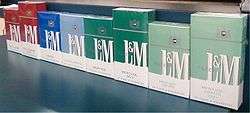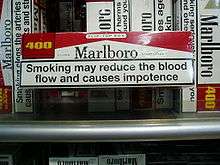Cigarette pack



A pack or packet of cigarettes is a rectangular container, mostly of paperboard, which contains cigarettes. The pack is designed with a flavor-protective foil, paper or biodegradable plastic, and sealed through a transparent airtight plastic film. By pulling the "pull-tabs", the pack is opened. Hard packs can be closed again after opening, whereas soft packs cannot.
Cigarette packs often contain warning messages depending on which country they are sold in.
Package size

Pack
The size of a pack is often regulated. Government agencies usually set a minimum pack size.
In Australia, the most common quantity per pack is 25, second to 20 which by law, is the minimum. 30, 40 and even 50 packs are also sold.
In Canada, most packs sold have 25 cigarettes, but packs of 20 are also popular.
In many European countries, increases of cigarette tax can cause the quantity of cigarettes in the pack to change, in order to achieve the same end price.
In Malaysia, the selling of packs containing fewer than 20 cigarettes is prohibited.
In the United States of America, the quantity of cigarettes in a pack must be at least 20. Certain brands, such as Export As, come in a pack of 25. For many years, half-packs of 10 (or even 14) cigarettes were commonly available.
In the United Kingdom brands are usually sold in packets of 20 but most popular brands are also available in 10s. Vending machines often dispense packets containing 16 or 18 cigarettes, although the dimensions of the packaging are the same as the equivalent packet containing 20.[1]
Carton
A carton of cigarettes usually contains 10 packs, totaling 200 cigarettes.[2] Some cartons contain twenty packs, totaling 400 cigarettes.[2]
Hard pack and soft pack

A hard pack is the usual style of paperboard packaging for store bought cigarettes, which consists of a relatively stable box. This successfully prevents the crumpling of cigarettes when kept in a person's pocket or handbag. The flip-top hard pack cigarette case was introduced in 1955 by Philip Morris.[3][4]

A soft pack is a box packaging made of thin paper, usually containing 20 cigarettes. Soft packs may be considered inconvenient as they rupture easily and cannot be resealed. They offer the immediate convenience of not having to open the package each time the smoker wants a cigarette. They require less physical 'pocket space' when fewer cigarettes remain in the pack. With American brands, cigarettes from a soft pack are usually a few millimeters longer than their hard-boxed counterparts.
Collectable pack

Some cigarette packs present a particular interest for collectors. There are cigarette packs labeled "collectible".
Some brands introduce promotional packs to bypass advertising laws. An example would be a limited time promotion where the pack is made from tin with the shape, purpose, and look of a cigarette case to entice potential buyers. They are distinguished by unique décor or are very old or they were removed from manufacturing for some reasons and consequently became rare.
Features
Most cigarette packs have no features at all and are just made up of a single container filled with cigarettes. However, some cigarette packs have been proposed that also contain an empty container for disposing the cigarette butts into. This could reduce cigarette butts of being discarded unto the street, where they contaminate the environment.[5][6]
Plain tobacco packaging
References
- ↑ "Cigarette Vending Packs". Licensed Trade Vending Supplies. Retrieved 15 April 2008.
- 1 2 "Cigarette Vending Packs". Licensed Trade Vending Supplies. Retrieved 15 April 2008.
- ↑ Gene Borio. "Tobacco Timeline: The Twentieth Century 1950–1999 – The Battle is Joined". Tobacco.org. Retrieved 21 July 2012.
- ↑ "Dealing With an Innovative Industry: A Look at Flavored Cigarettes Promoted by Mainstream Brands". Ncbi.nlm.nih.gov. 7 August 2005. Retrieved 21 July 2012.
- ↑ Cigarette packs with container for cigarette butts
- ↑ Patent for a cigarette packs with container for cigarette butts
